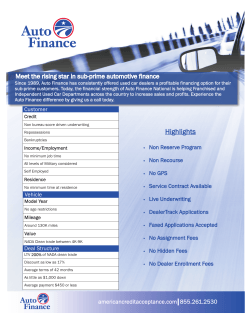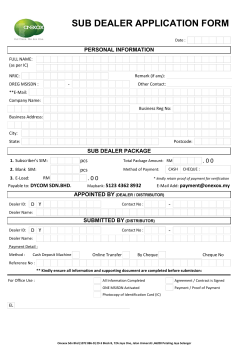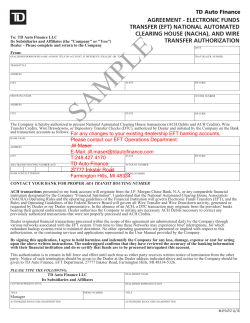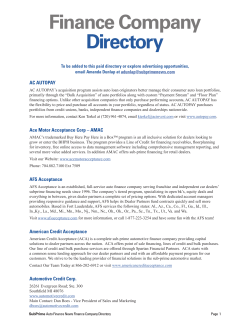
Auto Lending Regulation Accelerating
April 23, 2015 Auto Lending Regulation Accelerating What's Happening: We believe that there will be a strong negative regulatory catalyst in the coming weeks and months for companies operating in the auto lending sector, specifically those that focus on subprime customers as well as related firms such as auto dealerships. The risk stems from accusations of racial discrimination in lending patterns, the continued use of "dealer markups" in transactions between dealers, lenders, and the consumer, as well as a perception of deteriorating underwriting and an increase in defaults and inability to repay loans. The regulatory risk related to these issues emanates from both the Consumer Financial Protection Bureau (CFPB) as well as the Department of Justice Civil Rights Division (DOJ), led by Acting Assistant Attorney General Vanita Gupta, who previously worked as an activist litigator for the American Civil Liberties Union Center for Justice. She has been quoted as saying, "In every facet of the auto lending market, combatting discrimination is a top priority for the Civil Rights Division." Additional risks may also arise from certain state attorneys' general, especially those seeking higher office, such as California's Kamala Harris, who is currently running for US Senate. Why It Matters: There is a broad swath of companies facing these multifaceted risks, including non-bank lenders like Santander Consumer USA Holdings (SC), Skopos Financial Group, Exeter Finance Corp., Westlake Financial Services Inc., Pelican Auto Finance, banks such as Wells Fargo (WFC), Capital One Financial Group (COF), and J.P. Morgan Chase (JPM), and auto dealers that also offer financing such as CarMax (KMX), America's Car Mart (CRMT), Group 1 Automotive (GPI), Lithia Motors (LAD), Asbury Automotive Group (ABG), KAR Auction Services (KAR), Sonic Automotive (SAH), and AutoNation (AN). The first risk is the likely coming headlines of federal lawsuits and monetary damages. The involvement of the DOJ Civil Rights Division increases the magnitude of this risk, in contrast to only the CFPB bringing an enforcement action, as civil monetary penalties are far higher for racial discrimination than for other forms of predatory lending. Next, and potentially more detrimental, is that the terms of any settlement would likely require the lenders to cease to allow the use of dealer markups and other tools to avoid potential discrimination. These changes would be foisted upon both dealers and lenders, increasing both costs and credit risk. This type of settlement would also have an impact on the structured securities that contain these loans which would now be deemed predatory – as was the case with subprime housing loans, there is likely to be a decrease in the available pool of loans with high yields for investors. For companies that are targeted by any suit, there is also a risk that auto dealers, fearing reputation risk, reduce their business with accused lenders and shift towards larger banks that are better able to absorb the costs and regulatory hurdles. This shunning could severely constrain future cash flows, especially if a firm is highly leveraged or its existing loans are beginning to incur higher default rates. What's Next: As was the case prior to nearly all previous CFPB actions, there has been an uptick of mentions of auto lending by leaders of the bureau and a concerted media campaign to highlight the issue and increase the pressure on the targeted firms. Therefore, we expect an announcement in this area is likely to come this spring or in early summer not only to extract maximum political benefit, but also to highlight the issue in advance of the heavy summer car travel season. The Center for Responsible Lending (CRL) has reported that the CFPB has forwarded several complaints to DOJ this year and several more companies have made Securities and Exchange Commission filings, but we also believe that, similar to the national mortgage servicing settlement, there is a great deal of political upside for state attorneys general to pursue actions beyond those taken by these federal agencies. CFPB and DOJ Diagnosis of Lending Market Malfunction Out of all the intricacies of the auto lending market, one particular aspect has been flagged as the most problematic by consumer activists and federal officials – dealer markups. This pricing method, widely used by auto dealers, consists of several parts. First, the dealer sends a consumer's financial, credit, and personal information to the lender which will conduct underwriting. The lender then quotes an interest rate, know as the buy rate, to the dealer which the lender deems is sufficient to cover the credit risk to hold the loan in its portfolio or sell it to be securitized for investors. In most instances, the dealer is able to generate quotes from several lending firms and then selects the one with the best terms not only to get the consumer to buy the car, but also that best compensates the dealer. The dealer is then allowed to attempt to charge the consumer a higher total interest rate that includes a dealer markup if the dealer believes that the consumer will accept the higher cost. The dealer is compensated for this markup. CRL, among many other consumer activist and civil rights organizations, wants to ban dealer markups and institute a flat fee for all consumers so there is transparency and an inability to discriminate on terms beyond an interest rate based on credit risk. According to this view, the commentary to Regulation B of the Equal Credit Opportunity Act (ECOA) clearly states that a "market participant" is a creditor under the law when he or she participates in any credit decision. The higher rate charged via dealer markups would then include dealers in the final decision, despite auto dealers having been specifically carved out of CFPB jurisdiction under the Dodd-Frank Act. Any practices by those taking part in a credit decision that result in disparities in pricing, even if unintended, would be a violation of ECOA under the disparate impact and disparate treatment standards. In the CFPB's exact words, "The indirect auto lender may also have a policy that allows the dealer to mark up the interest rate above the indirect auto lender's buy rate. In the event that the dealer charges the consumer an interest rate that is higher than the lender's buy rate, the lender may pay the dealer what is typically referred to as 'reserve' (or 'participation'), compensation based upon the difference in interest revenues between the buy rate and the actual note rate charged to the consumer in the retail installment contract executed with the dealer...Because of the incentives these policies create, and the discretion they permit, there is a significant risk that they will result in pricing disparities on the basis of race, national origin, and potentially other prohibited bases." The bureau has repeatedly laid out in public documents and speeches several steps that lenders and dealers could take to prevent violation of ECOA and avoid resulting litigation. These include controlling dealer markups and compensation policies or outright eliminating dealer discretion for marking up buy rates and substituting flat fees per transaction. Despite telegraphing this strong regulatory view for over two years, most firms have yet to change their business model because there is acute fear of first mover disadvantage and because dealers are a particularly powerful political constituency that has the support of a majority of Congress. There is also a less discussed issue of the use of the disparate impact standard and its level of support in the courts. Currently, the Supreme Court is set to rule on a case, Texas Department of Housing and Community Affairs v. The Inclusive Communities Project, Inc., which considers the use of this standard for determining unintentional discrimination under the Fair Housing Act, which has similar language as ECOA (disparate impact and other unequal outcomes as discrimination are not specifically mentioned in statute). Thus, we believe that if the use of disparate impact is struck down under the Fair Housing Act, many of the same participants in the coming legal imbroglio on auto lending will assert that federal use of disparate impact is precluded in enforcement actions under ECOA. However, if the use of disparate impact is upheld by the court under the Fair Housing Act, it will further embolden the DOJ to pursue a disparate impact course of action based on dealer markups. Regulatory Route to Date Since the vast majority of Americans own a car (9 out of 10 commute to work via car according to CFPB) and over 80% of those owners use financing to purchase the vehicle, auto loans are the largest consumer purchases outside of a home mortgage or student loans. These loans are also typically paid before all other consumer debts, including student loans and mortgages because a car is essential to maintain a job and keep any cash flow for those other categories. The CFPB has publicly stated that it believes the surge in subprime auto lending since the recession has been driven, in large part, by a search for yield by investors. Lenders are responding to this demand accordingly and originating more subprime loans – evidence of which can be found in statements from the Office of the Comptroller of the Currency (OCC) and the Federal Reserve Senior Loan Officer Opinion Survey. At the same time, the pool of people considered subprime has also increased due to the financial impact of the most recent recession. The opening salvo of the dispute between the CFPB and auto lenders and dealers was a March 2013 CFPB Bulletin on Indirect Auto Lending and Compliance with the Equal Credit Opportunity Act. In that document, which the bureau viewed as simply restating current law and regulation, the CFPB established its displeasure with dealer markups as well as asserted that it could regulate dealers that held a role in the credit decision process. There was no significant continuing reaction from the industry to this bulletin except for an initial flurry of press releases and denunciations. The ante was raised later that year when the CFPB and the DOJ forced Ally into a settlement on December 20, 2013. Ally was viewed as a large target that did a significant amount of lending and had become a ward of the state as a result of the financial crisis. The firm was also in the midst of petitioning the Federal Reserve to become a financial holding company and thus begin to transition towards total private ownership. Due to the risks to the firm's business planning process, it chose to settle with both agencies. The time period in question was from April 2011 to March 2012 and under the terms of the settlement, Ally agreed to pay $98 million, but did not admit wrongdoing. Of that amount, $80 million still sits undistributed in an account because the CFPB, DOJ, and an appointed administrator cannot yet determine who of the estimated 235,000 minority borrowers are the rightful recipients of the money – essentially, the federal government cannot identify who qualifies as the protected racial classes mentioned in the settlement. A CFPB official has been quoted in the press as saying, "payments cannot be sent until all affected consumers have been given a full opportunity to participate in the settlement, which requires extensive preparation and outreach." Importantly, Ally also agreed to monitor its continued lending for future discrimination, but did not pledge to halt the use of offering loans to dealers using markups. This led to many outside activists to call on the bureau to use a rulemaking to ban dealer markups, a decision which has not been made over the past two years. The bureau has initiated a rulemaking covering only large non-bank participants in these markets, but not one on substantive policy changes under ECOA. We believe that this is because the CFPB is concerned that it is on shaky legal ground when forcing changes to business practices in this regard, especially if it loses access to disparate impact as a tool to prove discriminatory outcomes. CFPB also did not release its statistical methodology called Bayesian Improved Surname Geocoding in a prompt manner and only did so long after the settlement and a congressional outcry, creating additional political headaches and increased policy risks since the lenders and dealers did not have a method to self-analyze their portfolios to see if they were inadvertently discriminating. Next, in January 2014, the CRL released a lengthy and often cited report called NonNegotiable which discusses auto lending, specifically for borrowers of color. After publication of this report, the American Financial Services Association, which advocates on behalf of member auto lenders, put out a pointed rebuttal. This document is important because it shows investors the fundamental disconnect between regulators and market participants and why we believe that this situation can only be resolved with a legal victory by one side or another – the time for voluntary change or moderation is long past. "CRL simply ignores the fact that borrowers with 'poorer credit' – regardless of their background – will predictably and understandably pay higher rates than more credit-worthy borrowers." This is simply not acceptable under the law to the CFPB and even if intentional discrimination is not at issue, we expect that the CFPB will view a higher number of nonwhite borrowers paying higher interest rates in a portfolio of loans, especially when dealer markups continue to be allowed, as grounds for litigation. During a September 2014 field hearing in Indianapolis, IN, the CFPB finally proposed direct CFPB supervision of large nonbank auto lenders. The proposed rule is formally called Defining Larger Participants of the Automobile Financing Market and Defining Certain Automobile Leasing Activity as a Financial Product or Service. The comment period for the rule ended this past December and we believe that the final rule is likely to be announced at the same time as the anticipated legal action – further pushing companies to settle and change their business practices due to the ability of the bureau to directly supervise and examine their loan originations and portfolios in the future. During the field hearing, CFPB Director Richard Cordray made remarks that demonstrate how the bureau's focus is on ensuring that consumers have a similar experience in receiving their loan at any dealer, whether it is from a bank, nonbank lender, or the dealer itself: "This proposal [for regulation of non-bank auto lenders] is needed to level the playing field for banks and nonbanks in the auto lending market [CFPB supervises banks over $10 billion that lend in auto markets]...every auto lender should be following the law and be subject to the same level of oversight." At this hearing, the CFPB also chose to bow to pressure and release a white paper on its analysis of how it arrived at the Ally settlement, including the use of borrower last names and their place of residence at the time of the sale. From the white paper, "Census Data helps to calculate the probability that an individual belongs to a particular race and ethnicity based on last name and demographics of area in which they live." As comments were being collected on the large market participant rule, in November 2014 the CFPB fined an auto dealer, DriveTime, $8 million in its first ever action against a "buy here, pay here" dealer. According to the CFPB, "buy here, pay here" means that the dealers sell the car as well as originates and services the auto loan, typically targeting subprime borrowers. A few months later, this past February, the DOJ and CFPB settled with auto dealers Auto Fare Inc. and Southeastern Auto Corp. for intentionally discriminating against minority customers. In January 2015, the CRL published yet another white paper – Reckless Driving: Implications of Recent Subprime Auto Finance Growth. In this paper, the think tank highlights the dramatic increase in auto loan balances, particularly the dollar balance for those with subprime credit, which it states has roughly doubled since 2009, while originations for other nonsubprime credit score groups increased by only about half. CRL believes that lenders are loosening underwriting and extending loan terms – this increases the total amount paid for an automobile even if it is not necessarily worth more, and also increases the risk of consumer default. A longer term and a higher loan-to-value ratio makes the loan look more affordable in the short-term and also allows the dealer and lender to mask higher interest rates (often from dealer markups, according to CRL) and how that impacts the total cost of the loan. In response, in February 2015 Equifax released a study that refutes these concerns over subprime originations and attempted to counter the activist view (largely embraced by CFPB) that subprime mortgage lending and auto lending have similar predatory characteristics and that auto lending will have the same terrible results in the near future. Also in February, J.P. Morgan Chase stated that it is engaged in discussions with the DOJ and CFPB about its lending portfolio of over $50 billion in auto loans. The captive finance units of Honda Motor Co. and Toyota Motor Co. also disclosed at the end of 2014 that they were under investigation. Another regulatory agency, the Federal Trade Commission (FTC), also has jumped into the mix with Operation Ruse Control. Last month, the FTC brought several small suits against dealers for practices regarding auto loan modifications, deceptive advertising, and purchase of vehicle add-ons Finally, the most telling and damning public action occurred when CFPB Deputy Director Steven Antonakes gave a speech late last month at the Consumer Bankers Association's annual conference in Orlando, FL. He spent a large part of his remarks making the case that auto lending is now viewed at the bureau as one of the key "emerging risks" in the marketplace for consumer credit across the board, not just in terms of discrimination. Antonakes said, "The average term of a subprime auto loan for a new vehicle have increased every year since the crisis and is now at a length never seen before. At the same time, we have seen credit losses for recent loan vintages over the last two years rising from historically low levels, and some preliminary analysis suggests high levels of early delinquencies. Combined, these trends cause us to worry that subprime borrowers are being extended credit that they are unable to pay back. Given the potential harm for consumers, we will be keeping a close eye on these trends to address, as necessary, potentially unfair, deceptive, and abusive practices in this space." Future Road Map In determining the next steps for the regulation of this sector, we believe it is important to first understand what is not going to occur and then to use a recent speech by Senator Elizabeth Warren (D-MA) as a lens to understand the views of many at the CFPB and DOJ Civil Rights Division. Warrent said, "The auto loan market looks increasingly like the pre-crisis housing market, with good actors and bad actors mixed together...it is no coincidence that auto loans are now the most troubled consumer financial product. Congress should give the CFPB the authority it needs to supervise car loans–and keep that $26 billion [from dealer markup over life of loans according to CRL] a year in the pockets of consumers where it belongs." First, there is no chance that Congress will expand any CFPB powers in the next two years. Second, the use of the analogy between subprime auto lending and mortgage lending shows how regulators view participants in that market and the disdain with which they are held because they are believed to be bilking consumers out of billions of dollars, not to mention discriminating against them. Similar to payday loans, there is a general scorn for nonbank auto lenders and a lack of care about what any enforcement action would do to the marketplace in terms of reducing access to credit. With that mindset, we believe that CFPB and DOJ litigation against several large and small lenders is forthcoming, as well as a final rule for large market participants in the non-bank auto lending sector (covering approximately 90% of that market), likely before midsummer. The lawsuits could cover unfair and deceptive lending practices, racial discrimination under ECOA, or both issues. The bureau will shortly be able to analyze lenders' portfolios for patterns of discrimination and it and the DOJ want to achieve two objectives – the cessation of dealer markups and any patterns of disparate impact, as well as the loosening of underwriting and overextension of unaffordable credit (so-called reverse redlining) to subprime consumers. The bottom line for auto lenders and other market participants is that we belive the CFPB will try to use a legal settlement process to change business practices throughout the sector and that compliance costs and settlement costs will be a drain on profits. Additionally, any outstanding allegations of racial discrimination could give pause to dealers to do business with firms that are under scrutiny and fighting back against the government. This will especially be true if the firms in question have a large amount of debt and are highly dependent on the capital markets to secure financing – there is a risk that they will become over-leveraged on top of having to come up with millions for restitution to consumers and payment of federal fines. Website Twitter LinkedIn Email Copyright © 2015 Beacon Policy Advisors LLC 1776 I Street, NW, Suite 260 Washington, DC 20006 | (202) 909-2157 Our Compliance Policy Unsubscribe
© Copyright 2025










